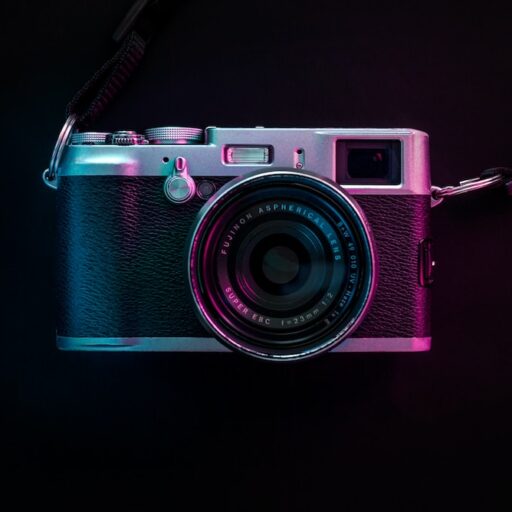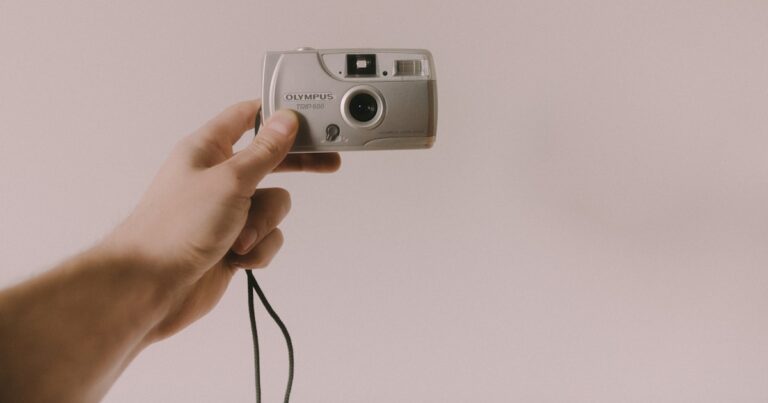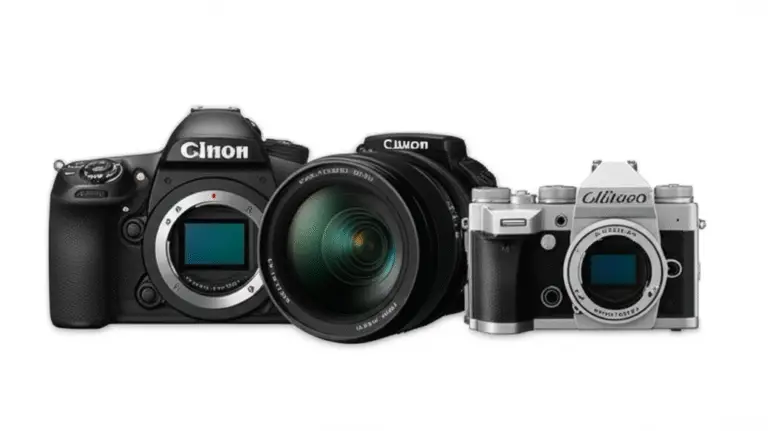Support our educational content for free when you purchase through links on our site. Learn more
📸 The Ultimate Digital Camera Guide (2025): 15 Must-Know Insights!
Ever wondered what makes a digital camera truly stand out in today’s tech-packed world? We’ve been behind the lens at Camera Brands™ for years, capturing moments and testing gear, and we’re here to spill the secrets. From sensor sizes that make your photos pop to the latest AI-powered autofocus tricks, this guide covers everything you need to know before snapping your next shot.
Did you know that despite smartphones dominating casual photography, dedicated digital cameras still offer superior image quality and creative control? Whether you’re a beginner hunting for your first DSLR or a pro eyeing medium format marvels, we break down the types, features, and future trends that will shape your photography journey in 2025 and beyond. Stick around for our expert tips on battery hacks, weather-sealing wonders, and the best brands that pros swear by!
Key Takeaways
- Sensor size and type are crucial for image quality—full-frame sensors reign supreme but APS-C and Micro Four Thirds offer excellent options for every budget and style.
- Mirrorless cameras are reshaping the market with compact designs and lightning-fast autofocus, but DSLRs still hold strong for rugged versatility.
- Mastering camera modes like aperture priority and manual unlocks creative freedom beyond automatic shooting.
- Connectivity features such as Wi-Fi and Bluetooth make sharing your masterpieces effortless.
- Top brands like Canon, Nikon, Sony, and Fujifilm continue to innovate, offering diverse options tailored to all skill levels.
- Accessories matter: invest in quality lenses, tripods, and memory cards to elevate your photography game.
Ready to explore the best digital cameras and gear?
- 👉 Shop Canon Cameras: Amazon | Canon Official Website
- Explore Sony Mirrorless: Amazon | Sony Official Website
- Discover GoPro Action Cameras: Amazon | GoPro Official Website
Dive in and let’s capture some magic together!
Table of Contents
- ⚡️ Quick Tips and Facts: Your Digital Camera Cheat Sheet!
- 📸 The Digital Camera Revolution: A Journey Through Imaging History
- 🔍 Decoding the Digital Eye: Understanding Image Sensors and Their Magic
- 🎯 Finding Your Perfect Match: A Deep Dive into Digital Camera Types DSLRs: The Classic Workhorses of Digital Photography
- Mirrorless Cameras: The Future of Digital Imaging is Here?
- Compact Cameras: Pocket Powerhouses for Everyday Moments
- Bridge Cameras: The Best of Both Worlds for Versatile Shooting
- Action Cameras: Adventure Ready and Built for Extremes
- 360-Degree Cameras: Immersive Worlds in Your Hand
- Medium Format Digital: The Ultimate Detail for Discerning Eyes
- 🎒 Beyond the Camera Body: Essential Digital Camera Accessories You Need
- 🧠 The Brains Behind the Beauty: Mastering Digital Camera Modes
- Automatic Modes: Point, Shoot, and Smile with Your Digital Camera
- Program Mode: A Little More Control for Your Digital Shots
- Aperture Priority: Mastering Depth of Field in Digital Photography
- Shutter Priority: Freezing Motion or Creating Blurs with Your Digital Camera
- Manual Mode: Unleash Your Inner Pro Photographer
- Scene Modes and Creative Filters: Adding Flair to Your Digital Photos
- 🔋 Powering Your Passion: Digital Camera Batteries and Longevity Tips
- 💾 Storing Your Masterpieces: Image Data Storage Solutions for Digital Photographers
- 🔗 Staying Connected: Digital Camera Connectivity Options for Seamless Sharing
- 🌧️ Built to Last: Weather-Sealing and Waterproofing for Digital Cameras
- 📱 The Digital Revolution’s Reach: Cameras in Your Pocket and Beyond
- 🏆 The Titans of Imaging: Notable Digital Camera Manufacturers
- Canon: The Red Dot Legacy in Digital Photography
- Nikon: The Yellow Stripe Powerhouse of Digital Imaging
- Sony: Innovation Unleashed in Mirrorless Digital Cameras
- Fujifilm: Retro Charm, Modern Performance in Digital Photography
- Panasonic/OM System (Olympus): Micro Four Thirds Mastery
- Leica: The Legend Lives On in Digital Photography
- GoPro: The Action Hero of Digital Cameras
- 📈 The Evolving Landscape: Digital Camera Market Trends and Future Innovations
- 🎞️ Bringing Film to the Digital Age: Converting Analog Cameras for Modern Use
- ✨ Conclusion: Your Digital Photography Journey Awaits!
- 📚 Recommended Links: Dive Deeper into Digital Photography!
- ❓ FAQ: Your Burning Digital Camera Questions Answered
- 🔗 Reference Links: Our Sources for Digital Camera Expertise
Quick Tips and Facts: Your Digital Camera Cheat Sheet!
To get the most out of your digital camera, it’s essential to understand its capabilities and limitations. Here are some quick tips and facts to enhance your photography experience:
- Always clean your lens to prevent smudges and scratches.
- Understand your camera’s modes, including automatic, aperture priority, shutter priority, and manual.
- Familiarize yourself with ISO settings to optimize your camera’s performance in various lighting conditions.
- Experiment with different angles to add creativity to your photos.
- Use a tripod for sharper images, especially in low-light conditions.
For more information on choosing the best digital camera brand, check out our article on What Brand Is Best for Digital Cameras? Top 10 Picks (2025).
The Digital Camera Revolution: A Journey Through Imaging History
The history of digital cameras is a fascinating story of innovation and technological advancements. From the first digital camera, developed in 1975 by Steven Sasson at Eastman Kodak, to the modern mirrorless cameras of today, the industry has come a long way.
According to Wikipedia, the first commercial digital camera, the Dycam Model 1, was released in 1990. Since then, digital cameras have become an essential part of our lives, with most smartphones now featuring high-quality cameras.
Decoding the Digital Eye: Understanding Image Sensors and Their Magic
Image sensors are the heart of any digital camera, responsible for capturing light and converting it into digital signals. There are two primary types of image sensors: CCD (Charge-Coupled Device) and CMOS (Complementary Metal-Oxide-Semiconductor).
Sensor Size Matters: Full-Frame, APS-C, and Micro Four Thirds Explained
Sensor size plays a crucial role in determining the quality of your images. Full-frame sensors offer the best image quality, while APS-C and Micro Four Thirds sensors are more compact and suitable for smaller cameras.
| Sensor Type | Size | Crop Factor |
|---|---|---|
| Full-Frame | 36mm x 24mm | 1x |
| APS-C | 23.6mm x 15.7mm | 1.5x |
| Micro Four Thirds | 17.3mm x 13mm | 2x |
Megapixels: Is More Always Better for Your Digital Photos?
While a higher megapixel count can result in more detailed images, it’s not always the most critical factor. Other aspects like sensor size, lens quality, and image processing also play a significant role in determining image quality.
ISO Performance: Conquering Low Light with Your Digital Camera
ISO settings control the sensitivity of your camera’s sensor to light. A lower ISO (e.g., ISO 100) is suitable for bright lighting conditions, while a higher ISO (e.g., ISO 6400) is better for low-light situations.
Finding Your Perfect Match: A Deep Dive into Digital Camera Types
With so many digital camera types available, choosing the right one can be overwhelming. Here are some of the most popular types:
- DSLRs: The Classic Workhorses of Digital Photography
- Pros: Excellent image quality, interchangeable lenses, and manual controls.
- Cons: Bulky, heavy, and often expensive.
- Mirrorless Cameras: The Future of Digital Imaging is Here?
- Pros: Compact, lightweight, and fast autofocus.
- Cons: Limited battery life, expensive lenses.
- Compact Cameras: Pocket Powerhouses for Everyday Moments
- Pros: Small, lightweight, and easy to use.
- Cons: Limited manual controls, lower image quality.
- Bridge Cameras: The Best of Both Worlds for Versatile Shooting
- Pros: Long zoom range, manual controls, and compact design.
- Cons: Lower image quality, limited low-light performance.
- Action Cameras: Adventure Ready and Built for Extremes
- Pros: Rugged, waterproof, and compact.
- Cons: Limited manual controls, lower image quality.
- 360-Degree Cameras: Immersive Worlds in Your Hand
- Pros: Unique perspective, compact design.
- Cons: Limited manual controls, lower image quality.
- Medium Format Digital: The Ultimate Detail for Discerning Eyes
- Pros: Exceptional image quality, manual controls.
- Cons: Expensive, bulky, and heavy.
Beyond the Camera Body: Essential Digital Camera Accessories You Need
To get the most out of your digital camera, you’ll need some essential accessories:
Lenses: Your Creative Canvas for Digital Photography
Lenses can make or break your photography experience. From wide-angle to telephoto, each lens type offers unique creative possibilities.
Tripods and Stabilizers: Steady Shots, Sharp Digital Images
A tripod or stabilizer can help you capture sharper images, especially in low-light conditions.
Lighting: Shaping Your Vision with Digital Camera Lighting Gear
Lighting can dramatically impact your images. From natural light to artificial lighting, understanding how to work with light is crucial for photography.
Bags and Protection: Keeping Your Digital Camera Gear Safe
Protect your investment with a camera bag and lens cleaning kit.
Memory Cards: The Digital Canvas for Your Masterpieces
Memory cards are essential for storing your images. Choose a card with sufficient storage capacity and fast data transfer speeds.
The Brains Behind the Beauty: Mastering Digital Camera Modes
Understanding your camera’s modes is key to capturing stunning images:
Automatic Modes: Point, Shoot, and Smile with Your Digital Camera
Automatic modes are perfect for beginners or when you need to capture a quick shot.
Program Mode: A Little More Control for Your Digital Shots
Program mode offers more control than automatic modes, allowing you to adjust settings like ISO and white balance.
Aperture Priority: Mastering Depth of Field in Digital Photography
Aperture priority mode lets you control the aperture, allowing for creative control over depth of field.
Shutter Priority: Freezing Motion or Creating Blurs with Your Digital Camera
Shutter priority mode gives you control over the shutter speed, perfect for capturing motion or creating artistic blurs.
Manual Mode: Unleash Your Inner Pro Photographer
Manual mode offers complete control over your camera’s settings, allowing for precise adjustments and creative freedom.
Scene Modes and Creative Filters: Adding Flair to Your Digital Photos
Scene modes and creative filters can add a unique touch to your images, from landscape to portrait modes.
Powering Your Passion: Digital Camera Batteries and Longevity Tips
To keep your camera powered, you’ll need a digital camera battery. Here are some tips for extending battery life:
- **Use a **[*l]*(https://www.amazon.com/s?k=digital+camera+battery&tag=bestbrands0a9-20) 
- ****Use a l] camera **guide to learn more about **digital camera features
Storing Your Masterpieces: Image Data Storage Solutions for Digital Photographers
To store your images, you’ll need a memory card or cloud storage solution:
Memory Card Types: SD, CFexpress, XQD – Which is Right for Your Digital Camera?
Choose a memory card that fits your camera’s requirements and offers sufficient storage capacity.
Cloud Storage and Backup Strategies: Protecting Your Digital Photo Library
Cloud storage services like Google Photos or Amazon Prime Photos can help you backup and store your images safely.
Staying Connected: Digital Camera Connectivity Options for Seamless Sharing
To share your images, you’ll need a digital camera with connectivity options:
Wi-Fi and Bluetooth: Seamless Sharing from Your Digital Camera
Wi-Fi and Bluetooth enable wireless transfer of images from your camera to your smartphone or computer.
USB and HDMI: Wired Connections for Your Digital Photography Workflow
USB and HDMI ports allow for wired connections, perfect for transferring images or viewing them on a larger screen.
Built to Last: Weather-Sealing and Waterproofing for Digital Cameras
To protect your camera from the elements, look for weather-sealing or waterproofing features:
- 👉 CHECK PRICE on: Amazon | Walmart | eBay
- 👉 Shop weather-sealed digital cameras on: Amazon | Walmart | eBay
The Digital Revolution’s Reach: Cameras in Your Pocket and Beyond
The impact of digital cameras extends beyond traditional photography:
- Smartphones have become an essential part of our daily lives, with high-quality cameras integrated into these devices.
- Action cameras like GoPro have enabled us to capture stunning footage in extreme conditions.
- 360-degree cameras have opened up new possibilities for immersive photography and videography.
The Titans of Imaging: Notable Digital Camera Manufacturers
The digital camera industry is dominated by several notable manufacturers:
Canon: The Red Dot Legacy in Digital Photography
Canon is a well-known brand in the photography world, offering a wide range of digital cameras from DSLRs to mirrorless models.
Nikon: The Yellow Stripe Powerhouse of Digital Imaging
Nikon is another prominent brand, famous for its DSLRs and mirrorless cameras.
Sony: Innovation Unleashed in Mirrorless Digital Cameras
Sony has been at the forefront of mirrorless technology, offering a range of innovative cameras with advanced features.
Fujifilm: Retro Charm, Modern Performance in Digital Photography
Fujifilm is known for its retro-style cameras with modern features, offering a unique blend of style and substance.
Panasonic/OM System (Olympus): Micro Four Thirds Mastery
Panasonic and OM System (Olympus) are prominent players in the Micro Four Thirds market, offering a range of cameras with excellent image quality.
Leica: The Legend Lives On in Digital Photography
Leica is a legendary brand in the photography world, known for its high-end DSLRs and mirrorless cameras.
GoPro: The Action Hero of Digital Cameras
GoPro is a popular brand for action cameras, offering a range of rugged and compact cameras for extreme sports and activities.
The Evolving Landscape: Digital Camera Market Trends and Future Innovations
The digital camera market is constantly evolving, with new trends and innovations emerging:
Computational Photography: The Smart Side of Digital Cameras
Computational photography is a rapidly growing field, enabling cameras to capture and process images using advanced algorithms and machine learning.
AI Integration: Smarter Shooting with Your Digital Camera
AI integration is becoming increasingly common in digital cameras, offering features like autofocus, image recognition, and scene detection.
Video Capabilities: The Rise of Hybrid Digital Camera Shooters
Video capabilities are becoming more important in digital cameras, with many models offering 4K resolution, slow-motion, and time-lapse features.
Bringing Film to the Digital Age: Converting Analog Cameras for Modern Use
Converting analog cameras to digital can be a challenging but rewarding process:
- 👉 CHECK PRICE on: Amazon | Walmart | eBay
- 👉 Shop digital camera conversion kits on: Amazon | Walmart | eBay
For a deeper dive into digital cameras, check out the B&H Photo Video Pro Audio video on “Is the Ricoh GR IV Your Next Everyday Camera?” which covers the topic and could be helpful in understanding the features and capabilities of digital cameras.
Conclusion: Your Digital Photography Journey Awaits!
Wow, what a ride through the dazzling world of digital cameras! From the humble beginnings of the first digital image sensors to today’s AI-powered mirrorless marvels, the evolution of digital cameras has been nothing short of spectacular. We’ve unpacked sensor sizes, camera types, essential accessories, and even the future trends shaping photography.
If you’re still wondering which camera to pick, here’s the takeaway: there’s no one-size-fits-all. DSLRs like the Canon EOS 5D series excel in ruggedness and versatility, while Sony’s Alpha mirrorless lineup dazzles with compactness and cutting-edge tech. For casual shooters, compact and bridge cameras offer simplicity without sacrificing quality, and action cams like GoPro let you capture adrenaline-pumping moments with ease.
Remember our earlier question about megapixels? More isn’t always better—sensor quality and lens optics often trump sheer pixel count. And those mysterious camera modes? Mastering aperture and shutter priority unlocks creative control that automatic modes just can’t match.
So, whether you’re a weekend snapper or a pro chasing the perfect shot, the digital camera world has something for you. Dive in, experiment, and most importantly—have fun capturing your moments!
Recommended Links: Dive Deeper into Digital Photography!
- Canon Cameras: Amazon | Canon Official Website | Walmart
- Nikon Cameras: Amazon | Nikon Official Website | Walmart
- Sony Mirrorless Cameras: Amazon | Sony Official Website | Walmart
- Fujifilm Cameras: Amazon | Fujifilm Official Website | Walmart
- GoPro Action Cameras: Amazon | GoPro Official Website | Walmart
- Memory Cards: Amazon | Walmart
- Camera Bags & Tripods: Amazon | Walmart
Recommended Books for Aspiring Photographers
- Understanding Exposure by Bryan Peterson — Amazon
- The Digital Photography Book by Scott Kelby — Amazon
- Mastering Aperture, Shutter Speed, ISO and Exposure by Al Judge — Amazon
FAQ: Your Burning Digital Camera Questions Answered What are the best digital cameras for beginners?
For beginners, ease of use and affordability are key. Cameras like the Canon EOS Rebel T8i or Nikon D3500 offer intuitive controls, helpful guides, and excellent image quality. Mirrorless options like the Sony Alpha a6100 provide compactness and fast autofocus, great for learning. Look for cameras with automatic modes and user-friendly interfaces to ease your entry into photography.
Read more about “What Camera Brand Do Professionals Use? Top 7 Picks for 2025 📸”
How do digital cameras work?
Digital cameras capture light through a lens onto an image sensor (either CCD or CMOS), which converts photons into electrical signals. These signals are processed into digital data, stored as image files (JPEG or RAW). The camera’s processor applies corrections and compression, allowing instant preview and storage on memory cards.
Read more about “📸 What Type of Camera Is Most Popular? The Top 12 Revealed (2025)”
What features should I look for in a digital camera?
Focus on:
- Sensor size: Larger sensors (full-frame or APS-C) generally yield better image quality.
- Lens options: Interchangeable lenses offer versatility.
- Image stabilization: Helps reduce blur.
- Connectivity: Wi-Fi, Bluetooth for easy sharing.
- Battery life: Especially important for long shoots.
- Video capabilities: If you plan to shoot video.
- Build quality: Weather-sealing if you shoot outdoors.
Read more about “Top 8 Camera Companies in the World for Capturing Moments (2025) 📸”
How do I choose between a DSLR and a mirrorless camera?
DSLRs have an optical viewfinder and often longer battery life, with a wide lens ecosystem. Mirrorless cameras are lighter, more compact, and offer electronic viewfinders with real-time exposure previews. Mirrorless tech is advancing rapidly, often outperforming DSLRs in autofocus and video. Your choice depends on your shooting style, size preference, and budget.
Read more about “📸 The 15 Best Cameras in the World for 2025: Ultimate Guide”
What is the difference between digital and film cameras?
Film cameras capture images chemically on film, while digital cameras capture images electronically on sensors. Digital cameras offer instant image review, easier editing, and higher shooting capacity without film costs. Film can produce unique aesthetic qualities and dynamic range but requires developing and scanning.
Read more about “📸 Top 10 Best Cameras for Photography in 2025: Expert Picks & Secrets”
How can I improve my photography skills with a digital camera?
Practice regularly, experiment with manual modes to understand exposure, study composition techniques, and analyze your photos critically. Use tutorials, join photography communities, and consider workshops. Don’t be afraid to make mistakes—each shot is a learning opportunity!
Read more about “📸 Best Camera Companies in India (2025): Our Top 6 Picks Revealed!”
What accessories are essential for digital camera users?
- Extra batteries: Never run out of juice mid-shoot.
- Memory cards: Multiple cards with high speed and capacity.
- Tripod: For sharp images and long exposures.
- Camera bag: Protect your gear.
- Lens cleaning kit: Keep your optics spotless.
- External flash or lighting: For better illumination.
- Remote shutter release: For reducing camera shake.
Reference Links: Our Sources for Digital Camera Expertise
- Digital Camera – Wikipedia
- Canon Official Website
- Nikon Official Website
- Sony Electronics – Cameras
- Fujifilm X Series
- GoPro Official Site
- B&H Photo Video: More Than Just a Camera Store – Shop Now
- Target Cameras & Camcorders
We hope this comprehensive guide lights your path to capturing breathtaking moments with your digital camera. Ready to snap your masterpiece? 📸✨








